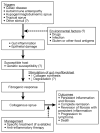Gluten-free diet and steroid treatment are effective therapy for most patients with collagenous sprue
- PMID: 20060071
- PMCID: PMC3493150
- DOI: 10.1016/j.cgh.2009.12.023
Gluten-free diet and steroid treatment are effective therapy for most patients with collagenous sprue
Abstract
Background & aims: Collagenous sprue (CS) is characterized by the presence of a distinctive band of subepithelial collagen deposition in the small bowel. We evaluated the clinical characteristics, treatments, and outcomes of patients with CS.
Methods: Thirty patients with CS were identified at the 3 Mayo Clinic sites between 1993 and 2009. Clinical data from medical records were reviewed.
Results: The study cohort was 70% female (age range, 53-91 years). Most patients had severe diarrhea and weight loss. Hospitalization to treat dehydration was necessary in 16 (53%) patients. Associated immune-mediated diseases were noted in 70% of the patients; celiac disease was the most frequent. Other associated diseases were microscopic colitis, hypothyroidism, and autoimmune enteropathy. The median thickness of the layer of subepithelial collagen deposition in the small bowel was 29 mum (20-56.5 mum). Subepithelial collagen deposition in the colon or stomach was noted in 8 patients. A clinical response was observed in 24 (80%) patients after treatment with a combination of a gluten-free diet and immunosuppressive drugs. Histologic improvement was confirmed in 9 patients, with complete remission in 5. Two patients died (1 of complications of CS and 1 of another illness).
Conclusions: Most patients with CS are treated effectively with a combination of gluten-free diet and steroids. CS is often associated with collagen deposition or chronic inflammation in other segments of the gastrointestinal tract as well as other immune-mediated disorders.
Copyright 2010 AGA Institute. Published by Elsevier Inc. All rights reserved.
Conflict of interest statement
The authors declare no conflicts.
Figures



Similar articles
-
Comparison of clinical features, treatment, and outcomes of collagenous sprue, celiac disease, and collagenous colitis.J Gastroenterol Hepatol. 2017 Jan;32(1):120-127. doi: 10.1111/jgh.13592. J Gastroenterol Hepatol. 2017. PMID: 27620860
-
[Collagenous sprue: a case description].Klin Med (Mosk). 2007;85(2):70-2. Klin Med (Mosk). 2007. PMID: 17520895 Russian.
-
Collagenous sprue: a clinicopathologic study of 12 cases.Am J Surg Pathol. 2009 Oct;33(10):1440-9. doi: 10.1097/PAS.0b013e3181ae2545. Am J Surg Pathol. 2009. PMID: 19641452
-
Monitoring nonresponsive patients who have celiac disease.Gastrointest Endosc Clin N Am. 2006 Apr;16(2):317-27. doi: 10.1016/j.giec.2006.03.005. Gastrointest Endosc Clin N Am. 2006. PMID: 16644460 Review.
-
Pediatric Collagenous Gastritis and Colitis: A Case Series and Review of the Literature.J Pediatr Gastroenterol Nutr. 2018 Sep;67(3):328-334. doi: 10.1097/MPG.0000000000001975. J Pediatr Gastroenterol Nutr. 2018. PMID: 29601434 Review.
Cited by
-
Gastroenterology Practice Patterns Contribute to Missed Diagnoses of Eosinophilic Gastritis and Duodenitis.Gastro Hep Adv. 2022 Nov 25;2(3):334-342. doi: 10.1016/j.gastha.2022.11.010. eCollection 2023. Gastro Hep Adv. 2022. PMID: 39132645 Free PMC article.
-
Severe spruelike enteropathy associated with olmesartan.Mayo Clin Proc. 2012 Aug;87(8):732-8. doi: 10.1016/j.mayocp.2012.06.003. Epub 2012 Jun 22. Mayo Clin Proc. 2012. PMID: 22728033 Free PMC article.
-
Coexisting Collagenous Sprue and Celiac Disease: A Case Report.Case Rep Gastroenterol. 2025 Apr 2;19(1):246-252. doi: 10.1159/000543939. eCollection 2025 Jan-Dec. Case Rep Gastroenterol. 2025. PMID: 40177217 Free PMC article.
-
Diarrhoea due to small bowel diseases.Best Pract Res Clin Gastroenterol. 2012 Oct;26(5):581-600. doi: 10.1016/j.bpg.2012.11.013. Best Pract Res Clin Gastroenterol. 2012. PMID: 23384804 Free PMC article. Review.
-
Collagenous sprue: a coeliac disease look-alike with different treatment strategy.BMJ Case Rep. 2014 Mar 28;2014:bcr2014203721. doi: 10.1136/bcr-2014-203721. BMJ Case Rep. 2014. PMID: 24682141 Free PMC article.
References
-
- Weinstein WM, Saunders DR, Tytgat GN, et al. Collagenous sprue: an unrecognized type of malabsorption. N Engl J Med. 1970;283:1297–1301. - PubMed
-
- Brandborg LL. Histologic diagnosis of diseases of malabsorption. Am J Med. 1979;67:999–1006. - PubMed
-
- Schein J. Syndrome of non tropical sprue with hitherto undescribed lesions of the intestine. Gastroenterology. 1947;8:438–460. - PubMed
-
- Pepper HW, Brandborg LL, Shanser JD, et al. Collagenous sprue. Am J Roentgenol Radium Ther Nucl Med. 1974;121:275–282. - PubMed
Publication types
MeSH terms
Substances
Grants and funding
LinkOut - more resources
Full Text Sources

